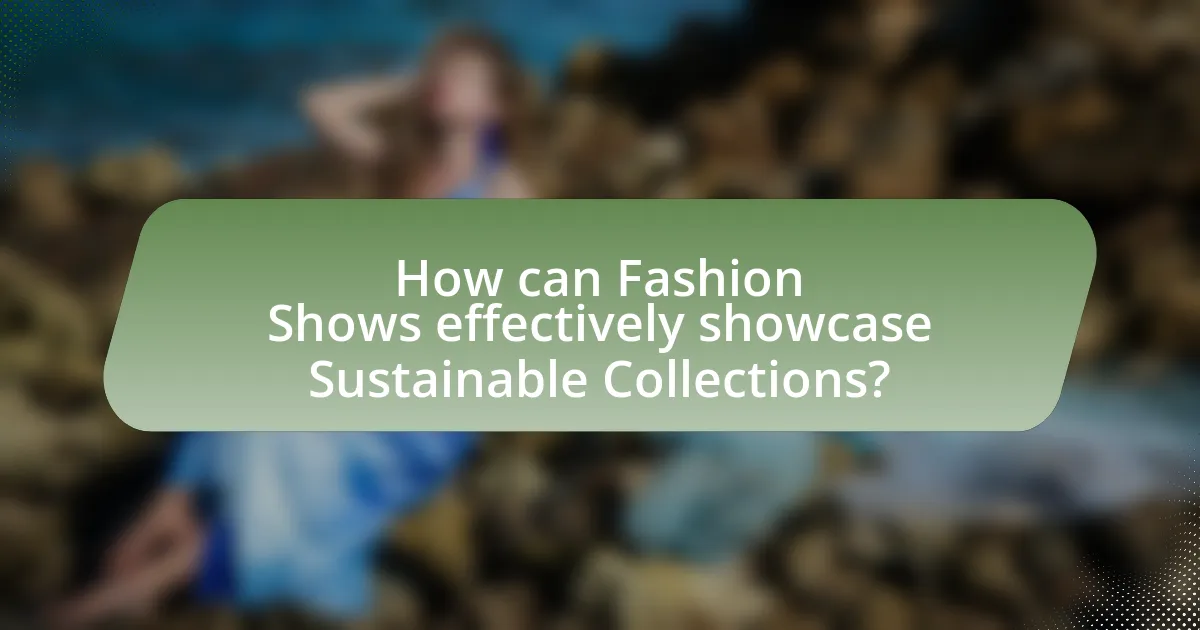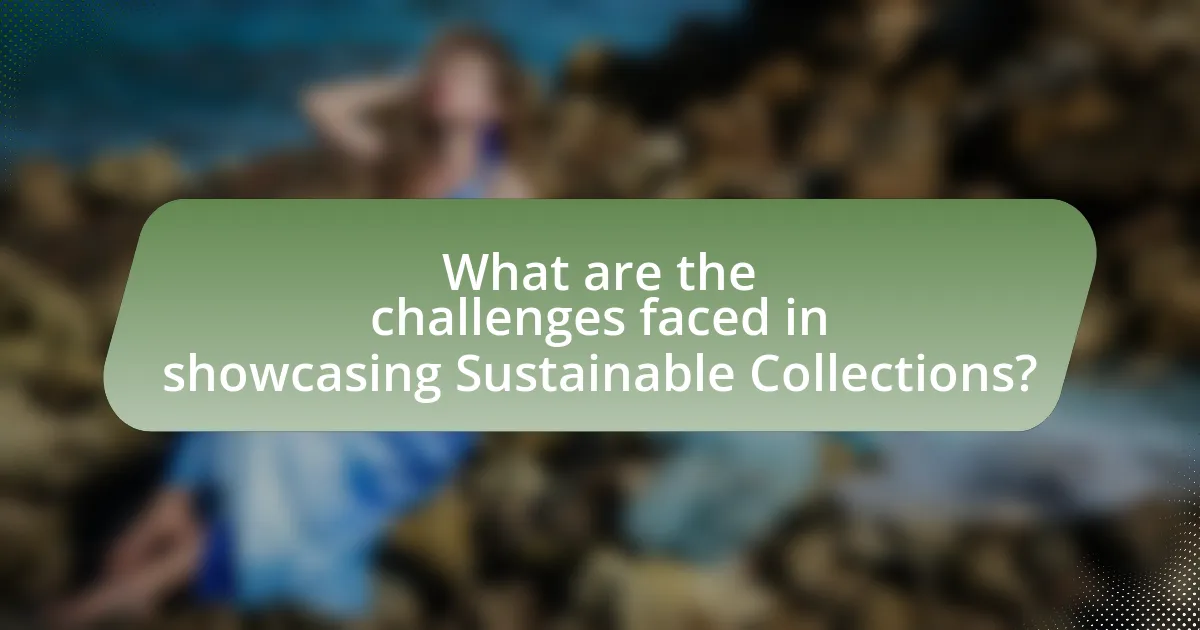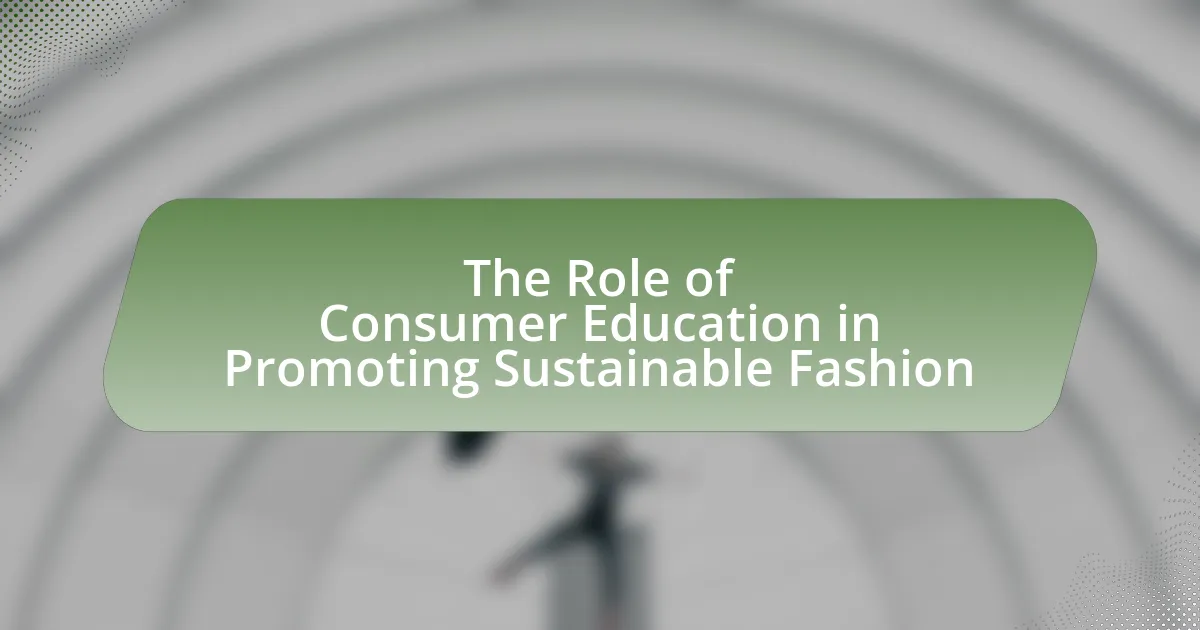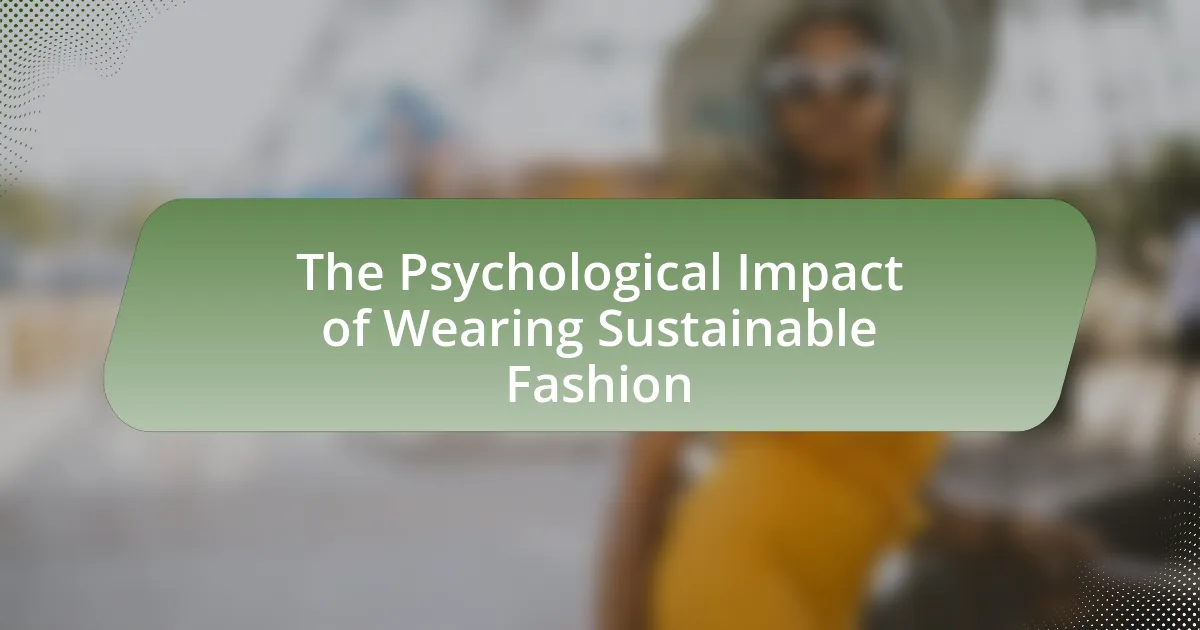Fashion shows with a purpose are events that aim to promote social, environmental, or charitable causes through fashion, often featuring sustainable collections that emphasize ethical practices. These shows highlight eco-friendly materials and fair labor conditions, raising awareness about the fashion industry’s impact on the environment and society. Designers play a crucial role by creating collections that prioritize sustainability, while fashion shows serve as platforms for educating audiences and influencing consumer behavior towards responsible choices. The article explores strategies for effectively showcasing sustainable collections, the challenges faced in this endeavor, and the importance of collaboration and transparency in promoting sustainable fashion practices.

What are Fashion Shows with a Purpose?
Fashion shows with a purpose are events designed to promote social, environmental, or charitable causes through the medium of fashion. These shows often feature sustainable collections that highlight ethical practices, such as the use of eco-friendly materials and fair labor conditions. For instance, the Fashion for Good initiative showcases designers who prioritize sustainability, aiming to raise awareness about the impact of the fashion industry on the environment and society. By integrating purpose into their presentations, these fashion shows not only entertain but also educate audiences on critical issues, fostering a more responsible approach to fashion consumption.
How do Fashion Shows promote sustainability?
Fashion shows promote sustainability by showcasing eco-friendly designs and raising awareness about sustainable practices within the fashion industry. These events often feature collections made from organic materials, recycled fabrics, and innovative production methods that minimize environmental impact. For instance, brands like Stella McCartney and Eileen Fisher have used fashion shows to highlight their commitment to sustainability, demonstrating how fashion can align with environmental responsibility. Additionally, fashion shows can serve as platforms for discussions on sustainability, encouraging industry stakeholders to adopt more sustainable practices and influencing consumer behavior towards eco-conscious choices.
What role do designers play in sustainable fashion shows?
Designers play a crucial role in sustainable fashion shows by creating collections that prioritize eco-friendly materials and ethical production practices. They are responsible for conceptualizing and executing designs that not only showcase aesthetic appeal but also communicate the importance of sustainability in the fashion industry. For instance, designers often select organic fabrics, utilize zero-waste patterns, and incorporate upcycled materials, which collectively reduce environmental impact. This approach not only highlights innovative design but also educates audiences about sustainable practices, reinforcing the message that fashion can be both stylish and responsible.
How can fashion shows raise awareness about environmental issues?
Fashion shows can raise awareness about environmental issues by showcasing sustainable fashion practices and highlighting the impact of the fashion industry on the environment. By featuring eco-friendly materials, ethical production methods, and innovative designs that prioritize sustainability, these events educate audiences on the importance of responsible consumption. For instance, the 2021 Copenhagen Fashion Summit emphasized the need for a circular economy in fashion, demonstrating how brands can reduce waste and carbon footprints. Such initiatives not only inform attendees but also inspire industry stakeholders to adopt more sustainable practices, ultimately fostering a broader conversation about environmental responsibility in fashion.
Why is showcasing sustainable collections important?
Showcasing sustainable collections is important because it raises awareness about environmental issues and promotes responsible consumer behavior. By highlighting eco-friendly practices and materials, brands can educate consumers on the impact of their purchasing decisions, fostering a shift towards sustainability in the fashion industry. Research indicates that 66% of global consumers are willing to pay more for sustainable brands, demonstrating a growing demand for environmentally conscious products. This shift not only benefits the planet but also enhances brand loyalty and market competitiveness.
What impact do sustainable collections have on consumer behavior?
Sustainable collections significantly influence consumer behavior by increasing purchase intent and brand loyalty. Research indicates that consumers are more likely to buy products from brands that demonstrate environmental responsibility, with 66% of global consumers willing to pay more for sustainable brands, according to a Nielsen report. This shift in behavior is driven by a growing awareness of environmental issues and a desire to support ethical practices in the fashion industry. Additionally, sustainable collections often enhance brand perception, leading to a stronger emotional connection between consumers and brands that prioritize sustainability.
How do sustainable fashion shows influence industry standards?
Sustainable fashion shows influence industry standards by promoting eco-friendly practices and setting benchmarks for ethical production. These events showcase innovative materials and sustainable design processes, encouraging brands to adopt similar practices. For instance, the Copenhagen Fashion Summit, a leading sustainable fashion event, has led to commitments from major brands like H&M and Gucci to improve their sustainability efforts. By highlighting the importance of transparency and responsible sourcing, sustainable fashion shows drive industry-wide changes, pushing companies to align with consumer demand for ethical fashion.

How can Fashion Shows effectively showcase Sustainable Collections?
Fashion shows can effectively showcase sustainable collections by integrating eco-friendly materials, emphasizing ethical production practices, and utilizing innovative presentation techniques. By featuring garments made from organic, recycled, or upcycled materials, designers can highlight the environmental benefits of their collections. For instance, brands like Stella McCartney have successfully used sustainable fabrics, demonstrating that high fashion can align with ecological responsibility. Additionally, incorporating storytelling elements that communicate the brand’s commitment to sustainability can engage the audience and enhance the impact of the presentation. Research indicates that consumers are increasingly drawn to brands that prioritize sustainability, with a Nielsen report showing that 66% of global consumers are willing to pay more for sustainable brands. This alignment between consumer values and fashion showcases can drive both awareness and sales for sustainable collections.
What strategies can be employed to highlight sustainability in fashion shows?
To highlight sustainability in fashion shows, organizers can implement strategies such as using eco-friendly materials, showcasing sustainable brands, and incorporating educational elements about sustainability. Eco-friendly materials, like organic cotton or recycled fabrics, reduce environmental impact and demonstrate commitment to sustainability. Showcasing sustainable brands emphasizes the importance of ethical practices in fashion, as evidenced by the rise of brands like Stella McCartney, which prioritizes sustainability in their collections. Additionally, incorporating educational elements, such as panels or informational displays, can inform attendees about the environmental impact of fashion, reinforcing the message of sustainability. These strategies collectively enhance the visibility of sustainable practices within the fashion industry.
How can storytelling enhance the presentation of sustainable collections?
Storytelling can enhance the presentation of sustainable collections by creating an emotional connection between the audience and the brand’s values. This connection fosters a deeper understanding of the environmental and social impacts of the products, making the audience more likely to engage with and support the collection. For instance, brands that share narratives about their sourcing practices, the artisans behind the products, or the ecological benefits of their materials can effectively communicate their commitment to sustainability. Research indicates that consumers are 55% more likely to purchase from brands that tell compelling stories, as these narratives resonate on a personal level and encourage brand loyalty.
What visual elements are essential for showcasing sustainability?
Essential visual elements for showcasing sustainability include natural materials, eco-friendly color palettes, and imagery that highlights environmental impact. Natural materials, such as organic cotton or recycled fabrics, visually communicate a commitment to sustainability. Eco-friendly color palettes, often inspired by nature, reinforce the message of environmental consciousness. Imagery that depicts sustainable practices, like renewable energy sources or waste reduction, further emphasizes the importance of sustainability in fashion. These elements collectively create a strong visual narrative that aligns with sustainable values and practices in the fashion industry.
How can collaboration enhance sustainable fashion shows?
Collaboration can enhance sustainable fashion shows by pooling resources, expertise, and creativity from various stakeholders, leading to more impactful presentations. When designers, brands, and organizations work together, they can share sustainable practices, reduce costs, and amplify their message about environmental responsibility. For instance, partnerships between fashion brands and eco-friendly material suppliers can result in innovative designs that highlight sustainable textiles, thereby educating audiences on the importance of sustainable choices. Additionally, collaborative efforts can attract a wider audience, as combined marketing strategies and shared networks increase visibility and engagement. This collective approach not only strengthens the sustainability narrative but also fosters a community committed to ethical fashion, as evidenced by initiatives like the Fashion for Good program, which brings together multiple players in the industry to drive sustainable innovation.
What partnerships are beneficial for promoting sustainable fashion?
Collaborations between fashion brands and environmental organizations are beneficial for promoting sustainable fashion. These partnerships leverage the expertise of environmental groups to educate consumers about sustainable practices and the impact of fashion on the environment. For instance, brands like Stella McCartney have partnered with organizations such as the World Wildlife Fund to promote sustainable sourcing and conservation efforts. Additionally, collaborations with universities and research institutions can drive innovation in sustainable materials and production techniques, as seen in projects like the Fashion for Good initiative, which fosters partnerships among brands, manufacturers, and innovators to create a more sustainable fashion ecosystem.
How can influencers and activists contribute to the success of these shows?
Influencers and activists can significantly contribute to the success of fashion shows focused on sustainable collections by leveraging their platforms to raise awareness and drive engagement. Their established audiences allow them to amplify the message of sustainability, reaching a broader demographic that may not be aware of the importance of eco-friendly fashion. For instance, a study by the Global Fashion Agenda indicates that 66% of consumers are willing to pay more for sustainable brands, highlighting the potential impact influencers can have on consumer behavior. By promoting these shows through social media, influencers can create buzz and attract attendees, while activists can provide authenticity and credibility to the cause, encouraging participation and support for sustainable practices in the fashion industry.

What are the challenges faced in showcasing Sustainable Collections?
The challenges faced in showcasing Sustainable Collections include limited consumer awareness, high production costs, and the difficulty of communicating sustainability effectively. Limited consumer awareness hampers the reach and impact of sustainable fashion, as many consumers remain uninformed about the benefits and importance of sustainable practices. High production costs arise from sourcing eco-friendly materials and implementing ethical labor practices, which can deter brands from fully committing to sustainability. Additionally, effectively communicating the sustainability of collections is challenging, as brands must navigate complex narratives and avoid greenwashing, which can undermine consumer trust. These challenges collectively hinder the successful promotion and acceptance of sustainable fashion in the marketplace.
What obstacles do designers encounter when creating sustainable collections?
Designers encounter several obstacles when creating sustainable collections, primarily including limited access to sustainable materials, higher production costs, and consumer demand for fast fashion. Limited access to sustainable materials restricts designers’ ability to source eco-friendly fabrics, as many suppliers do not offer a wide range of sustainable options. Higher production costs arise from the use of ethically sourced materials and sustainable manufacturing processes, making it challenging for designers to price their collections competitively. Additionally, consumer demand for fast fashion often conflicts with sustainable practices, as many consumers prioritize low prices and quick turnaround times over environmental considerations. These factors collectively hinder designers’ efforts to create and promote sustainable collections effectively.
How can budget constraints affect the presentation of sustainable fashion?
Budget constraints can significantly limit the presentation of sustainable fashion by restricting the resources available for showcasing collections. When budgets are tight, designers may opt for simpler, less elaborate presentations, which can reduce the impact and visibility of sustainable fashion messages. For instance, high-quality materials and innovative staging that highlight sustainability may be sacrificed for cost-effective alternatives, leading to a less compelling narrative. Additionally, limited budgets can restrict marketing efforts, resulting in lower audience engagement and awareness of sustainable practices. This is evident in studies showing that brands with higher marketing budgets tend to achieve greater visibility and consumer interest, underscoring the importance of financial investment in effective presentations.
What logistical issues arise in organizing sustainable fashion shows?
Logistical issues in organizing sustainable fashion shows include sourcing eco-friendly materials, managing transportation emissions, and ensuring ethical labor practices. Sourcing eco-friendly materials can be challenging due to limited availability and higher costs compared to conventional options. Managing transportation emissions is crucial, as moving models, staff, and materials can contribute significantly to the carbon footprint of the event. Additionally, ensuring ethical labor practices requires careful vetting of suppliers and production processes, which can complicate logistics and timelines. These factors collectively impact the feasibility and execution of sustainable fashion shows.
How can these challenges be overcome?
To overcome the challenges of showcasing sustainable collections in fashion shows, organizers can implement a multi-faceted approach that includes collaboration with eco-conscious brands, utilizing innovative materials, and engaging in transparent storytelling. Collaboration with brands committed to sustainability ensures a diverse range of eco-friendly designs, while innovative materials, such as recycled fabrics, reduce environmental impact. Engaging in transparent storytelling allows designers to communicate the sustainability efforts behind their collections, fostering consumer awareness and support. For instance, a study by the Fashion Institute of Technology highlights that transparency in sourcing and production can increase consumer trust and drive sales for sustainable brands.
What best practices can be implemented for successful sustainable fashion shows?
Successful sustainable fashion shows can be achieved by implementing practices such as using eco-friendly materials, minimizing waste, and promoting inclusivity. Eco-friendly materials, like organic cotton and recycled fabrics, reduce environmental impact and align with sustainability goals. Minimizing waste involves strategies like digital invitations and reusing set designs, which can cut down on resource consumption. Promoting inclusivity ensures diverse representation on the runway, reflecting the values of sustainability and social responsibility. According to a report by the Global Fashion Agenda, sustainable practices in fashion can significantly reduce carbon emissions and resource usage, validating the importance of these best practices.
How can technology aid in the promotion of sustainable collections?
Technology can aid in the promotion of sustainable collections by enhancing visibility and engagement through digital platforms. For instance, virtual fashion shows utilize live streaming and social media to reach a global audience, allowing brands to showcase their sustainable practices and products without the environmental impact of traditional shows. Additionally, augmented reality (AR) and virtual reality (VR) can create immersive experiences that educate consumers about the sustainability of materials and production processes. According to a report by McKinsey & Company, digital engagement can increase consumer awareness and interest in sustainable fashion, leading to higher sales and brand loyalty.
What are the key takeaways for organizing a successful sustainable fashion show?
To organize a successful sustainable fashion show, focus on three key takeaways: sourcing eco-friendly materials, promoting ethical practices, and engaging the audience with educational content. Sourcing eco-friendly materials ensures that the garments showcased have minimal environmental impact, as studies indicate that sustainable fabrics can reduce carbon emissions by up to 30%. Promoting ethical practices, such as fair labor conditions and transparency in the supply chain, builds trust with consumers and aligns with the values of the sustainable fashion movement. Engaging the audience with educational content, such as workshops or discussions on sustainability, enhances awareness and encourages responsible consumer behavior, which is crucial in driving the sustainable fashion agenda forward.
What tips can help ensure a meaningful impact through sustainable fashion shows?
To ensure a meaningful impact through sustainable fashion shows, organizers should prioritize transparency in sourcing materials and production processes. This approach builds trust with the audience and highlights the ethical practices behind the collections. Additionally, incorporating educational elements, such as workshops or panels, can engage attendees and raise awareness about sustainability issues in fashion. Research indicates that events that include interactive components can enhance participant understanding and retention of information, leading to a more profound impact. Furthermore, collaborating with local artisans and sustainable brands can strengthen community ties and promote local economies, which is essential for fostering a holistic approach to sustainability in fashion.
How can feedback be utilized to improve future sustainable fashion events?
Feedback can be utilized to improve future sustainable fashion events by systematically collecting and analyzing participant responses to identify strengths and weaknesses. This process allows organizers to understand attendee preferences, logistical challenges, and the effectiveness of sustainability messaging. For instance, surveys conducted after events can reveal specific areas for improvement, such as the need for better communication about sustainable practices or enhanced engagement activities. Research indicates that events that actively incorporate participant feedback see a 30% increase in satisfaction ratings, demonstrating the tangible benefits of this approach. By implementing changes based on feedback, organizers can create more impactful and engaging sustainable fashion events that resonate with their audience.




